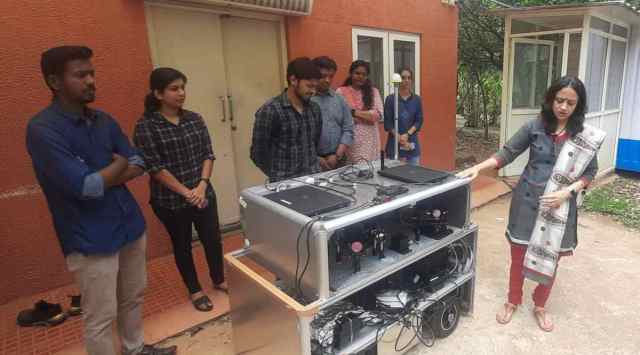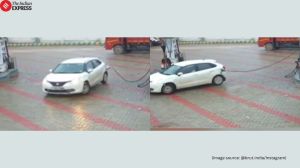Bengaluru’s Raman Research Institute reports breakthrough towards securing quantum communication via satellites
Team head Dr Urbasi Sinha said the development had many security applications, including those pertaining to elections, online banking and electoral systems.
 Dr Urbasi Sinha demonstrates the 'Bob' receiver with her team members at the Raman Research Institute in Bengaluru(File)
Dr Urbasi Sinha demonstrates the 'Bob' receiver with her team members at the Raman Research Institute in Bengaluru(File) A team of researchers at the Raman Research Institute’s (RRI) Quantum Information and Computing Lab based in Bengaluru achieved a breakthrough in March this year in their efforts towards using satellites for secure quantum communication, in collaboration with ISRO’s UR Rao Satellite Centre. This is part of the QUEST initiative (Quantum experiments using satellite technology).
This involved the demonstration of secure communication between a stationary device and a moving receiver using Quantum Key Distribution, with the help of a Pointing, Acquisition and Tracking system. While the Raman Research Institute has previously demonstrated the transmission of quantum keys between two stationary points in 2021, the present feat has been achieved in India for the first time.
Explaining the relevance of this development, team head Dr Urbasi Sinha noted that it had many security applications, including those pertaining to elections, online banking and electoral systems. Modern systems are protected by classical cryptography relying on the mathematical complexity of the encryption keys which are sent, which could be broken by quantum computers developed in the future, she said. On the other hand, the counter to this would be the distribution of the keys using quantum communication. The use of satellites in this form of communication would also bypass the limitations caused by the curvature of the Earth.
While Chinese teams have demonstrated the possibility of communication from a satellite to ground stations with entangled photons (quantum entangled particles retain similar characteristics while being far from each other), RRI is aiming to demonstrate “uplink”, or ground-to-satellite capability in the future. According to Dr Sinha, this would provide much more flexibility as the photon source could be on the ground and not inside a satellite.
Researchers also noted that the sheer precision required in these operations was also a challenge as the accuracy must be far higher than in radio transmissions. RRI’s mechanical engineering workshop also pitched in, constructing the wheeled moving receiver platform.
In a statement explaining the experiment, Dr Sinha noted, “First, we developed x-y tracking without the use of sophisticated gimbal mechanisms. Later, we used the gimbal mechanism to fine-tune the tracking in several degrees of freedom. To mimic the satellite motion, we advanced from a home-built linear track to a home-built circular track. And finally, an entire moving vehicle was built and carefully aligned to the receiver module with attendant optics, opto-mechanics and electronics – all working in tandem with the high-end time synchronisation solutions which were also developed.”
Interestingly, the sender platform was nicknamed ‘Alice’ and the receiver ‘Bob’, in reference to two characters who have been used for decades in research papers and discussions in the form of examples of people communicating with each other, mostly with reference to cryptographic studies.
“The next step will be to increase the efficiency of the system and carry out more miniaturisation,” Dr Sinha said.












